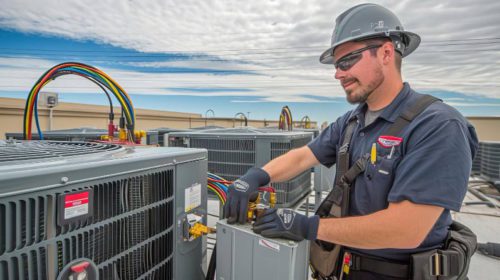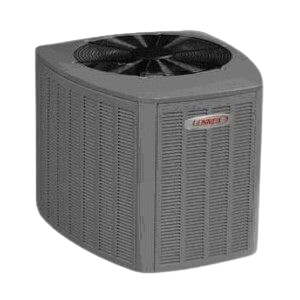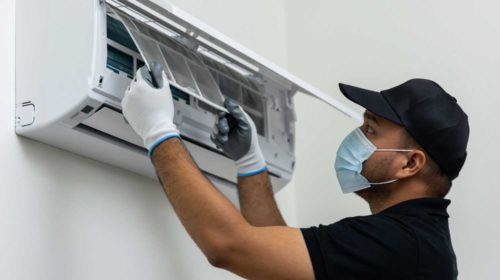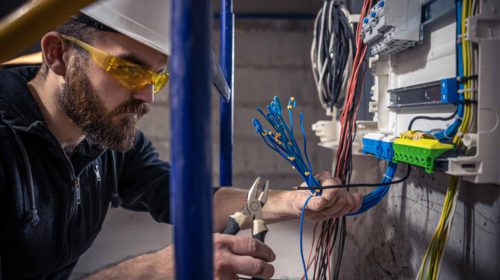
Air Conditioning Installation
London Ontario
Residential Air Conditioning Installation in London, Ontario

As the warm season approaches London, Ontario, ensuring your home's cooling system is reliable becomes crucial. Finan Home Service is here to offer exceptional air conditioning installation services, guaranteeing your comfort throughout the summer months. Our commitment to air conditioning installation is all-encompassing, focusing not just on setting up your new system but also on enhancing your unit's energy efficiency, reliability, and your overall peace of mind.
Our expert team at Finan Home Service is well-versed in the latest air conditioning technologies, allowing us to offer comprehensive installation services for a wide range of high-efficiency models that suit your specific needs and budget. Whether your old system is no longer effective or you're considering adding air conditioning for the first time, our skilled technicians work closely with you to determine the most suitable cooling solutions. We prioritize your satisfaction, ensuring a smooth installation process and addressing all of your cooling needs with attention to detail.
Imagine your home as a haven of cool, consistent comfort, powered by an air conditioning system operating at maximum efficiency, helping to lower your energy bills. This vision is within reach with Finan Home Service. Our professional installation services are meticulously planned to ensure your air conditioning system performs flawlessly, providing optimal cooling without excessive costs. Feel the comfort and assurance that comes from having your cooling system expertly installed and tailored to the unique needs of your home.
Don't let the summer heat compromise your comfort or safety. Reach out to Finan Home Service today to explore your air conditioning installation options. Our friendly team is ready to assist you every step of the way, providing expert advice and solutions customized for your home. Schedule your installation appointment now and take the first step towards a cooler, more efficient, and comfortable home this summer.
Contact Us Now!Four-Step Process for Finan Home Service Residential Furnace Service and Maintenance
Initial Consultation and System Assessment
Contact Finan Home Service to schedule a comprehensive assessment of your cooling system. Our experts will review the current state of your air conditioning unit, discuss any issues or concerns you have noticed, and identify any underlying problems. This essential first step allows us to determine the specific services or maintenance required to improve your air conditioner's efficiency and reliability, ensuring it meets your home's cooling needs and fits within your budget.
In-Depth System Evaluation
Before any service or installation tasks begin, we perform a thorough evaluation of your air conditioning unit and the overall cooling system. This process includes checking for any compatibility issues with existing components, confirming that our proposed service plan will enhance your system's performance, and developing a strategy to implement services or installation with minimal disruption to your daily life. Our goal is to identify both immediate and potential issues to prevent future breakdowns.
Expert Service and Installation
Our certified technicians will carry out the necessary services or complete the installation, adhering to the highest standards of safety and efficiency. We are committed to resolving any issues by using high-quality parts and materials for durable results. Our detailed-oriented approach ensures your air conditioning system receives the attention it needs to cool your home effectively and efficiently.
Thorough Inspection and Preventive Advice
After completing the service or installation, we conduct an extensive inspection to ensure your air conditioning system functions flawlessly. We also provide valuable advice on how to optimize your air conditioner's performance and suggest routine maintenance practices to extend its lifespan and maintain peak efficiency. Our ultimate aim is to leave you completely satisfied and confident in your cooling system's performance and reliability.
Why Choose Finan Home Service for Your Air Conditioning Installation

In the competitive field of air conditioning installation in London, Ontario, Finan Home Service emerges as the premier provider. Our unparalleled dedication to excellence, customized service approach, and unwavering commitment to your complete satisfaction distinguish us as the service provider of choice for discerning homeowners across the region.
Customized Installation and Expert Cooling Solutions At Finan Home Service, we understand that every homeowner and their cooling needs are unique. That's why our service begins with a comprehensive assessment to identify the specific requirements of your air conditioning system. Our experts guide you through the selection and installation process, focusing on solutions that enhance your home's efficiency and comfort. We take pride in offering installation services tailored to your needs, ensuring a personalized and thorough experience from start to finish.
Precision Installation by Skilled Technicians Our team of skilled technicians is equipped with the latest technology and methods, ensuring your air conditioning installation is performed with precision and efficiency. We adhere to strict safety and quality standards, ensuring your new cooling system is installed correctly and functions at its optimal level. Our commitment to excellence means you can expect a smooth and effective installation process.
Maximizing Efficiency for Energy Savings With a focus on sustainability and maximizing efficiency, Finan Home Service is dedicated to installing your air conditioning system in a way that not only cools your home effectively but also offers the potential for significant energy savings. Our goal is to improve your living space's comfort while promoting a greener, more efficient energy use that benefits both your wallet and the environment. Choosing us for your installation needs ensures a future of comfortable, efficient cooling for your home.
Exceptional Customer Support and Aftercare Our relationship with you doesn't end after the installation. We provide comprehensive support, including advice on how to maintain and optimize your new air conditioning system's performance, as well as troubleshooting assistance to ensure it continues to run smoothly. Our friendly and professional team is always available to provide the support you need, whenever you need it. At Finan Home Service, ensuring your satisfaction is our top priority, and we go above and beyond to meet your expectations.
Opting for Finan Home Service for your air conditioning installation means entrusting your home's comfort to a team that genuinely cares about your well-being. Let us create a cooler, more comfortable environment in your home this summer and for many years to come.
Contact Us Now!Our Air Conditioning Services in London, Ontario
Single-Stage Air Conditioners Service and Maintenance
For homes equipped with single-stage air conditioners, our thorough service includes a detailed examination of your unit to detect and fix any problems impacting its cooling efficiency and performance. Single-stage air conditioners, valued for their straightforward operation and consistent cooling, occasionally require adjustments or maintenance to keep them running optimally, particularly in larger homes. Our skilled technicians are adept at diagnosing and rectifying any complications, ensuring your air conditioner operates efficiently and integrates seamlessly with your home’s cooling system.
Two-Stage Air Conditioners Service and Maintenance
We offer specialized service for two-stage air conditioners, designed to maintain the enhanced comfort and efficiency these systems provide. Two-stage air conditioners can adjust their cooling output to better match your indoor climate requirements, offering improved energy efficiency and indoor comfort. Our service strategy includes precise adjustments and maintenance to support these advanced capabilities. By fine-tuning and servicing your system, we help it deliver a consistently comfortable and efficient cooling experience.
Variable-Speed Air Conditioners Service and Maintenance
The maintenance of variable-speed air conditioners, known for their superior efficiency and the ability to precisely control cooling output, requires a deep understanding of their complex systems. Our technicians possess the expertise necessary to ensure every component of your variable-speed air conditioning system functions perfectly. Our extensive service not only addresses any immediate issues but also enhances the overall efficiency of your cooling system. With careful attention to every detail, we strive to improve your air conditioner's performance, ensuring it delivers uniform, comfortable cooling throughout your home.
Buying a new air conditioner shouldn’t be an overwhelming experience. We know you have all sorts of questions when deciding on which new air conditioner unit to buy, ranging from: “Which AC brand is best” to “which AC features should I be choosing?”
Check out our Tips for Buying a New Air Conditioner video where John Finan explains the ins and outs of buying the best AC unit for your home:
Finan Home Service carries an extensive line of new air conditioner options that include Lennox, RUUD, and most other brands.
We also offer upfront pricing on all work, 24-hour live telephone support, a guaranteed appointment time, and financing for those who don’t want to put off a more energy efficient or cost effective new air conditioner.
Your home’s heating, ventilation, air conditioning or HVAC System is much like your children, some will be on their way in their late teens and others will be living in the basement well into their thirties and beyond! Let us help you make the best choice for your home! Plus, we're experts on all our units, so you can trust that your air conditioner installation will go smoothly.
Available Cooling Solutions

LENNOX SL28XCV
The best of everything Lennox has to offer to create an unprecedented whole-home comfort system that seamlessly and intelligently works together to stay finely tuned to your home and deliver consistently clean, perfect air.
View Product

LENNOX EL23XCV
This product offers variable-capacity operation, meaning it can adjust cooling output like a dimmer switch to perfectly match your energy use to your comfort needs. This also helps control humidity more accurately.
View Product

LENNOX ML14XC1
The ML14XC1 air conditioner is designed for smart energy use, and designed to last. Efficiency ratings of up to 17.00 SEER mean the ML14XC1 can reduce utility bills without any compromise in comfort. It may also make you eligible for local utility rebates.
View Product
Frequently Asked Questions
The necessity to replace an air conditioning (AC) system typically arises every 10 to 15 years, though this timeline can vary based on the brand, how often the system is used, and its maintenance history. Indications that it might be time for a replacement include escalating repair costs, diminished cooling efficiency, and an increase in energy consumption. Keeping up with routine maintenance can help extend the life of your AC unit, but the benefits of newer, more efficient models might also make upgrading an appealing option sooner.
To ascertain if your AC unit requires replacement, watch for critical signs like reduced efficiency, uneven cooling, recurring expensive repairs, and the age of the system. An AC that's over a decade old, struggles to maintain a set temperature, or incurs high repair costs may be more economically replaced than continually repaired.
Optimally, the replacement of an AC unit should be scheduled during the spring or fall. These seasons tend to be less busy for HVAC technicians, which could mean quicker installations and potentially lower costs. Replacing your AC during these cooler months also ensures your home is prepared for the heat of the summer.
Typically, an AC unit can last from 10 to 15 years, with diligent maintenance possibly extending its lifespan. The durability of your AC can be influenced by the quality of its installation, the brand's reputation, and environmental factors. Regular upkeep, such as cleaning and annual professional checks, plays a crucial role in maximizing the unit's life.
If your AC unit is nearing the end of its life, you might notice signs like rising energy bills, increased repair frequency, unusual sounds or odors from the system, and a failure to cool your home effectively. Other warning signs include the unit frequently turning on and off, higher indoor humidity levels, and visible deterioration of the unit. These indicators suggest it might be time to consider a new air conditioning system.
Yes, it is highly recommended to have a professional install your air conditioner for several important reasons:
Expertise and Experience Professional HVAC technicians have the training, expertise, and experience needed to properly install air conditioning systems. They understand the intricacies of how different models work and can ensure that your system is installed correctly, according to manufacturer specifications and local building codes.
Safety Installing an air conditioner involves handling refrigerants, electrical wiring, and sometimes even modifications to your home's structure. Professionals have the necessary tools and knowledge to handle these components safely, minimizing the risk of injury or property damage.
Efficiency and Performance A properly installed air conditioner operates more efficiently and effectively. Professionals know how to size an AC unit correctly for your space, ensuring that it cools your home as efficiently as possible. Incorrect installation can lead to poor performance, higher energy bills, and undue strain on the system, potentially shortening its lifespan.
Compliance with Regulations Air conditioner installation is subject to various local, state, and federal regulations, including those related to building codes and refrigerant handling. Professionals are familiar with these regulations and can ensure that your installation complies with all legal requirements.
Warranty Protection Many air conditioner warranties require installation by a certified professional for the warranty to remain valid. DIY installation could void your warranty, leaving you without coverage if the system malfunctions.
Time and Convenience Installing an air conditioner can be time-consuming, especially without prior experience. Hiring a professional saves you time and the hassle of trying to figure out the installation process yourself.
Long-Term Cost Savings Although hiring a professional involves upfront costs, it can save you money in the long run by ensuring your AC unit operates efficiently, avoiding unnecessary repairs due to improper installation, and extending the lifespan of your unit.
In summary, while it might seem like an added expense, enlisting the services of a professional for air conditioner installation is a wise investment in the long-term comfort, safety, and efficiency of your home.
Before installing an air conditioning (AC) system, there are several important factors to consider to ensure that you choose the right system for your home and that the installation process goes smoothly. Here's what you need to know:
-
Type of Air Conditioning System
Central AC Ideal for cooling multiple rooms or the entire house. Requires ductwork.
Ductless Mini-Split Best for homes without ductwork, providing targeted cooling in specific areas.
Window Units Suitable for cooling single rooms. Easy to install but less efficient for larger spaces.
Portable AC Flexible and easy to move from room to room, but not as efficient as other types.
Size and Capacity The size of the AC unit, measured in tons or BTUs (British Thermal Units), should be appropriate for the space you want to cool. An oversized or undersized unit can lead to inefficiency, increased energy costs, and uneven cooling. A professional HVAC technician can perform a load calculation to determine the right size.
Energy Efficiency Look at the Seasonal Energy Efficiency Ratio (SEER) rating of the AC unit. A higher SEER rating means greater efficiency and lower operating costs. Choosing an energy-efficient model can save you money in the long run.
Cost Consider both the upfront cost and the long-term operating costs. While higher efficiency models may have a higher initial price, they often result in lower utility bills over time.
-
Installation Requirements
Ductwork For central AC systems, ensure that your home's ductwork is in good condition or plan for the installation of new ductwork.
Electrical System Make sure your home's electrical system can handle the load of the new AC unit.
Placement Think about where the indoor and outdoor units will be placed for optimal performance and minimal noise disruption.
Professional Installation Hiring a professional HVAC technician is crucial for a successful installation. They can handle the technical aspects, ensure safety standards are met, and provide valuable advice on maintenance.
Maintenance and Service Understand the maintenance requirements of your new AC system. Regular maintenance is essential for keeping the system running efficiently and extending its lifespan.
Warranty and Aftercare Check the warranty provided with the AC unit. Some manufacturers offer extended warranties if the installation is performed by certified professionals.
Local Building Codes and Permits Familiarize yourself with local building codes and whether you need any permits for the installation. A professional installer can usually handle this aspect for you.
Rebates and Incentives Look for any available rebates or incentives for installing energy-efficient air conditioning systems. These can help offset the initial cost of the system. Taking the time to understand these factors and working with a qualified professional can help ensure that you select the right air conditioning system for your home and enjoy comfortable, efficient cooling for years to come.
The placement of an outdoor air conditioner (AC) unit, often referred to as the condenser unit, is crucial for its efficiency, performance, and lifespan. Here are some guidelines to help determine the best location for your outdoor AC unit:
Shady Area Place the unit in a location where it will be in the shade during the hottest parts of the day, but not directly under trees or shrubs where leaves and debris can accumulate and impair its efficiency.
Away from Direct Sunlight Direct sunlight on the AC unit can cause it to overheat, making it work harder and less efficiently. North or east sides of the home are typically cooler throughout the day.
On a Solid, Level Surface The unit should be installed on a solid, level surface to ensure proper operation. A concrete slab is commonly used for this purpose.
Away from Obstructions Ensure there's at least 2-3 feet of clearance around the unit and at least 5 feet of clearance above it to allow for adequate airflow and easy access for maintenance.
Away from Windows and Neighbors Try to position the unit away from windows to reduce noise disturbance inside your home. Also, consider your neighbors and place the unit as far away as possible from property lines to avoid noise issues.
Accessible for Maintenance While it's important to keep the unit out of high-traffic areas, it should still be easily accessible for maintenance, repairs, and cleaning.
Consider Aesthetics Think about how the unit will look in your outdoor space. Some homeowners choose to landscape around their AC units with shrubs or fencing to camouflage them, but remember to keep adequate clearance for airflow.
Away from Heat Sources Avoid placing the unit near heat-generating sources such as dryer vents, barbecue grills, or sunny walls, as these can affect the unit's efficiency.
Dry, Well-Drained Location The location should be dry and well-drained. Avoid areas where water pools or floods, as moisture can damage the unit.
Choosing the right location for your outdoor AC unit can enhance its performance, extend its service life, and save on energy costs. Always consult with a professional HVAC technician to assess your property and recommend the best installation spot based on these factors and the specific layout of your home and yard.
Covering your outdoor air conditioning unit during the winter months is a topic with varying opinions among HVAC professionals. However, there are some considerations to keep in mind that can help you make an informed decision:
Pros of Covering Your Outdoor AC Unit:
Protection from Debris A cover can protect the unit from leaves, twigs, and other debris that might clog the system.
Prevention of Ice and Snow Accumulation In areas with heavy snowfall, covering the unit can prevent ice and snow from accumulating inside, which could potentially damage the components.
Shielding from Moisture A cover can keep out excessive moisture that can lead to rust and corrosion over time.
Cons of Covering Your Outdoor AC Unit:
Moisture Trapping If the cover is not breathable, it can trap moisture inside, promoting rust and corrosion.
Pest Habitat A covered unit can provide a warm and sheltered space for rodents and insects, leading to potential damage from nesting.
Overlooking Maintenance A cover might make it easy to forget about the unit, leading to neglect of necessary off-season maintenance.
Best Practices for Covering Your Outdoor AC Unit:
Partial Cover Consider using a cover that only protects the top of the unit. This prevents debris and snow from entering the unit from above while still allowing moisture to escape from the sides.
Breathable Material If you choose to cover the whole unit, ensure the cover is made from a breathable material to prevent moisture accumulation.
Check Regularly Periodically check under the cover during the winter months to ensure there are no issues with pests or moisture.
Remove Before Starting Make sure to remove the cover before turning the unit on in the spring or summer to prevent damage.
Ultimately, whether to cover your outdoor AC unit in winter depends on your specific circumstances, including your local climate and the likelihood of debris accumulation. If you decide to use a cover, choosing the right type and monitoring the unit throughout the off-season is important. For the best advice tailored to your situation, consult with a local HVAC professional.
Read What Our Customers Have To Say About Us
Hands down the best experience and customer service I have received in years. Glyn and Austin came out to help me within a couple of hours of calling for an electrician to figure out why I didn’t have power to my furnace. They were kind and explained every step of the process. I will only use Finan Home Service going forward for all issues that arise in my home. I cannot thank you enough!!
Finana helped with our furnace when it was causing us issues. The team was extremely flexible and accommodating. The guys who came to help out were absolutely professional and super friendly. The team explained what was going wrong, what my options were, and didn't push or try to sell me anything I didn't need yet. When the time does come (hopefully longer than sooner) to replace my furnace there isn't another company I would even contemplate using.
Had Finan come out to fix a broken drainage pipe in our bathroom. Turned out to be a bigger job thanks to the previous homeowner's terrible DIY plumbing skills. Spoke to Sam at the office who very quickly set me up with the right peeps. The guys came out and were able to fix/replace the problem in less than 4 hours. Super friendly and professional. Will recommend to anyone looking for home service. Thanks again.
Great visit today from Connor and Cole! Friendly, informative, and great quality work and I am hard to please. Update: Had Connor back today to finish up the work. My new kitchen cabinets are going to look great and now the plumbing also looks great and allows for maximum storage under the sink. Quality work from a personable professional! Thank you!



